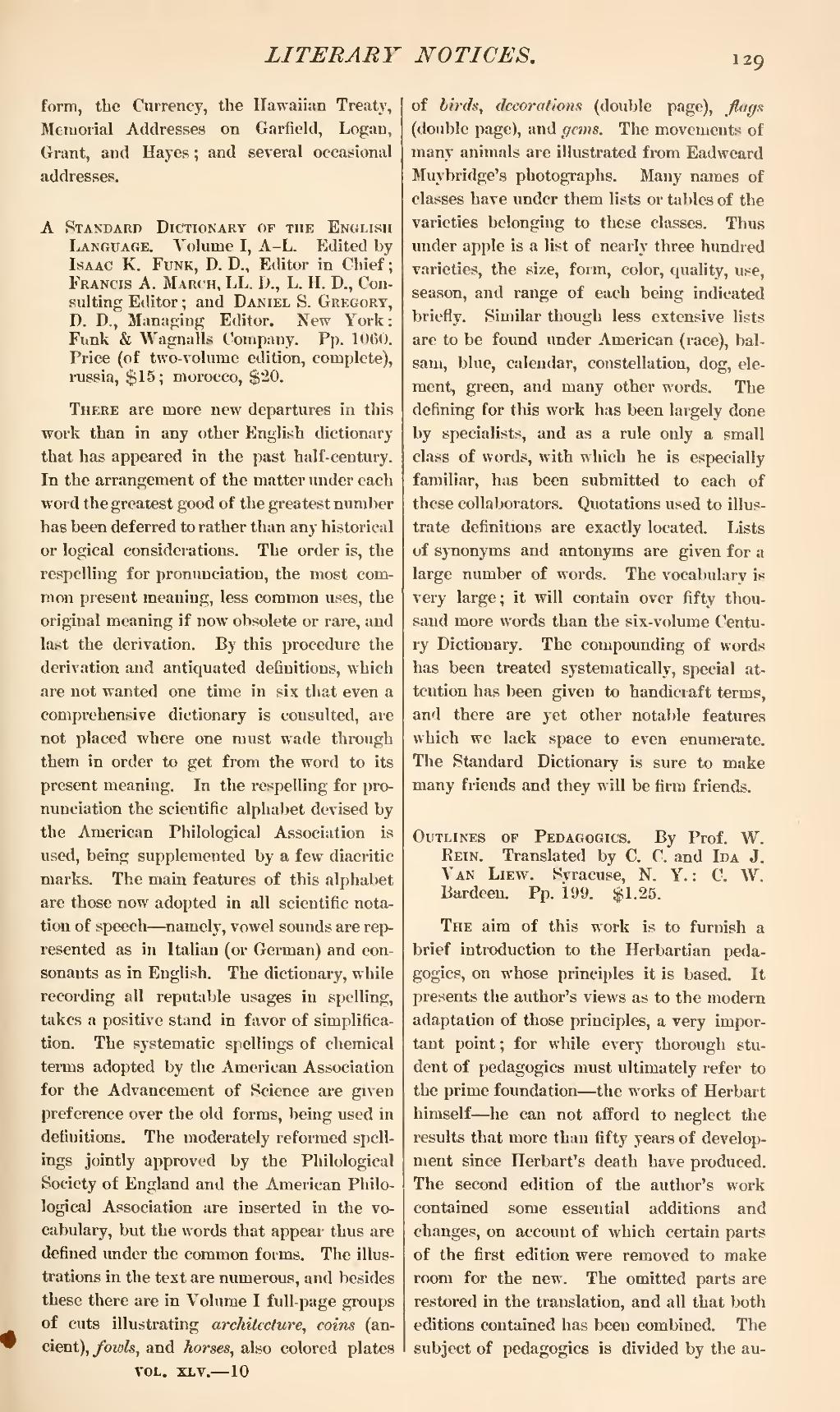form, the Currency, the Hawaiian Treaty, Memorial Addresses on Garfield, Logan, Grant, and Hayes; and several occasional addresses.
A Standard Dictionary of the English Language. Volume I, A-L. Edited by Isaac K. Funk, D. D., Editor in Chief; Francis A. March, LL. D., L. H. D., Consulting Editor; and Daniel S. Gregory, D. D., Managing Editor. New York: Funk & Wagnalls Company. Pp. 1060. Price (of two-volume edition, complete), russia, $15; morocco, $20.
There are more new departures in this work than in any other English dictionary that has appeared in the past half-century. In the arrangement of the matter under each word the greatest good of the greatest number has been deferred to rather than any historical or logical considerations. The order is, the respelling for pronunciation, the most common present meaning, less common uses, the original meaning if now obsolete or rare, and last the derivation. By this procedure the derivation and antiquated definitions, which are not wanted one time in six that even a comprehensive dictionary is consulted, are not placed where one must wade through them in order to get from the word to its present meaning. In the respelling for pronunciation the scientific alphabet devised by the American Philological Association is used, being supplemented by a few diacritic marks. The main features of this alphabet are those now adopted in all scientific notation of speech—namely, vowel sounds are represented as in Italian (or German) and consonants as in English. The dictionary, while recording all reputable usages in spelling, takes a positive stand in favor of simplification. The systematic spellings of chemical terms adopted by the American Association for the Advancement of Science are given preference over the old forms, being used in definitions. The moderately reformed spellings jointly approved by the Philological Society of England and the American Philological Association are inserted in the vocabulary, but the words that appear thus are defined under the common forms. The illustrations in the text are numerous, and besides these there are in Volume I full-page groups of cuts illustrating architecture, coins (ancient), fowls, and horses, also colored plates of birds, decorations (double page), flags (double page), and gems. The movements of many animals are illustrated from Eadweard Muybridge's photographs. Many names of classes have under them lists or tables of the varieties belonging to these classes. Thus under apple is a list of nearly three hundred varieties, the size, form, color, quality, use, season, and range of each being indicated briefly. Similar though less extensive lists are to be found under American (race), balsam, blue, calendar, constellation, dog, element, green, and many other words. The defining for this work has been largely done by specialists, and as a rule only a small class of words, with which he is especially familiar, has been submitted to each of these collaborators. Quotations used to illustrate definitions are exactly located. Lists of synonyms and antonyms are given for a large number of words. The vocabulary is very large; it will contain over fifty thousand more words than the six-volume Century Dictionary. The compounding of words has been treated systematically, special attention has been given to handicraft terms, and there are yet other notable features which we lack space to even enumerate. The Standard Dictionary is sure to make many friends and they will be firm friends.
Outlines of Pedagogics. By Prof. W. Rein. Translated by C. C. and Ida J. Van Liew. Svracuse, N. Y.: C. W. Bardeen. Pp. 199. $1.25.
The aim of this work is to furnish a brief introduction to the Herbartian pedagogics, on whose principles it is based. It presents the author's views as to the modern adaptation of,those principles, a very important point; for while every thorough student of pedagogics must ultimately refer to the prime foundation—the works of Herbart himself—he can not afford to neglect the results that more than fifty years of development since Herbart's death have produced. The second edition of the author's work contained some essential additions and changes, on account of which certain parts of the first edition were removed to make room for the new. The omitted parts are restored in the translation, and all that both editions contained has been combined. The subject of pedagogics is divided by the au-
